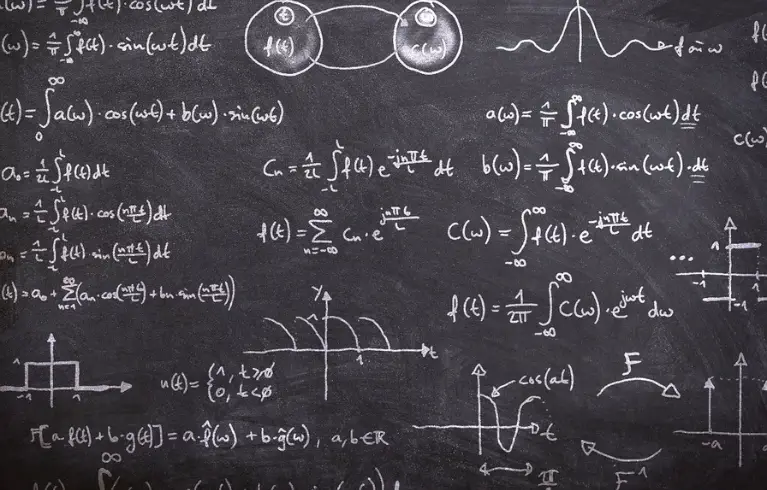The polar form of complex numbers is a mathematical representation that expresses a complex number in terms of its magnitude and argument. It is a useful alternative to the standard rectangular form, which represents a complex number as a sum of a real and imaginary part.
What is the polar form of complex numbers?
In the polar form, a complex number is written as $r(\cos\theta + i\sin\theta)$, where $r$ is the magnitude or modulus of the complex number, and $\theta$ is the argument or angle it makes with the positive real axis. This representation allows for a more intuitive understanding of complex numbers, as it relates them to the polar coordinate system.
Additionally, the polar form facilitates operations such as multiplication and division of complex numbers, as they can be performed by simply multiplying or dividing their magnitudes and adding or subtracting their arguments. Overall, the polar form of complex numbers provides a concise and geometrically meaningful representation that is widely used in various branches of mathematics and engineering.
De Moivre’s Theorem
Step into the captivating world of complex numbers, where De Moivre’s Theorem reigns supreme as one of the most vital and practical theorems. This remarkable theorem serves as a bridge between the enigmatic realm of complex numbers and the captivating realm of trigonometry. But its usefulness doesn’t stop there! De Moivre’s Theorem also unveils the intricate relationships between trigonometric functions of multiple angles, making it an indispensable tool in the mathematician’s arsenal.
De Moivre’s Theorem: For all $n$ and $\theta$, $$ (\cos\theta+i\sin\theta)^n=\cos(n\theta)+i\sin(n\theta).$$
Known by various names, such as “De Moivre’s Identity” and “De Moivre’s Formula,” this theorem pays homage to the brilliant mind of the esteemed mathematician, De Moivre. His contributions to the field of mathematics were nothing short of extraordinary, particularly in the realms of probability theory and algebra. So, let us delve into the depths of De Moivre’s Theorem and unlock the secrets it holds, as we follow in the footsteps of this mathematical luminary.
A selection of exercises about the polar form
| Exercise: Rewrite in the polar and the exponential polar form: \begin{align*} z_1=-1 – i \sqrt{3},\quad z_2= 3 + 3i,\qquad z_3=-\frac{4}{3}i \end{align*} | ➕ |
| The modulus of $z_1$ is \begin{align*} |z_1|=\sqrt{(-1)^2+(-\sqrt{3})^2}=\sqrt{4}=2. \end{align*} Let $\theta_1$ be the argument of $z_1$. We then have \begin{align*} \cos(\theta_1)&=\frac{{\rm Re}(z_1)}{|z_1|}=\frac{-1}{2},\cr \sin(\theta_1)&=\frac{{\rm Im}(z_1)}{|z_1|}=\frac{-\sqrt{3}}{2}. \end{align*} This shows that \begin{align*} \theta_1=\frac{4\pi}{3}+2k\pi,\quad k\in\mathbb{Z}. \end{align*} Thus \begin{align*} z_1=|z_1|e^{i\theta}=2 e^{i\frac{4\pi}{3}}. \end{align*} We need to give a representation of $z_1$ with a principal argument, i.e. belonging to $(-\pi,\pi]$. We can write $\frac{4\pi}{3}=\frac{-2\pi}{3}+2\pi$. Then \begin{align*} z_1=2 e^{i\frac{-2\pi}{3}}=2\left( \cos(\frac{-2\pi}{3})+i\sin(\frac{-2\pi}{3})\right). \end{align*} We have $z_2=3(1+i)$. Then $|z_2|=3\sqrt{1^2+1^2}=3\sqrt{2}$. Let $\theta_2$ be an argument of $z_2$. We have \begin{align*} \cos(\theta_2)=\frac{3}{3\sqrt{2}}=\frac{\sqrt{2}}{2}. \end{align*} Similarly, \begin{align*} \sin(\theta_2)=\frac{\sqrt{2}}{2}. \end{align*} We then obtain \begin{align*} \theta_2=\frac{\pi}{4}+2k\pi,\quad k\in\mathbb{Z}. \end{align*} Hence \begin{align*} z_2&=|z_2|e^{i\theta_2}=3\sqrt{2} e^{i\frac{\pi}{4}}\cr &= 3\sqrt{2}\left(\cos(\frac{\pi}{4})+\sin(\frac{\pi}{4})\right). \end{align*}Observe that $i=e^{i\frac{\pi}{2}}$. Then \begin{align*} z_3=-\frac{4}{3}i=-\frac{4}{3}e^{i\frac{\pi}{2}}. \end{align*} But this is not the good form as $-\frac{4}{3} < 0$. To overcome this obstacle we write $(-1)=e^{i\pi}$, so that \begin{align*} z_3&=\frac{4}{3}e^{i\pi} e^{i\frac{\pi}{2}}\cr &= \frac{4}{3} e^{i\frac{3\pi}{2}} \end{align*} We need a representation with a principal argument. We then write $e^{i\frac{3\pi}{2}}=e^{i\frac{4\pi-\pi}{2}}$. Thus \begin{align*} z_3=\frac{4}{3} e^{i\frac{-\pi}{2}}=\frac{4}{3} \left(\cos(\frac{-\pi}{2})+i\sin(\frac{-\pi}{2})\right). \end{align*} | |
| Exercise: Solve the equation $z^2=1+i$. | ➕ |
We recall that if $\alpha= r e^{i\theta},$ here $r>0$ and $\theta$ is a principal argument of $\alpha$, then the complex equation $z^2=\alpha$ has two roots: \begin{align*}z_1&=\sqrt{r}e^{i\frac{\theta}{2}}\;\text{and,}\cr z_2&=\sqrt{r}e^{i\left(\frac{\theta}{2}+\pi\right)}\end{align*} On the other hand, if we write $z$ and $\alpha$ is the algebraic form $z=x+iy$ and $\alpha=a+i b$ then using the fact that $z^2=x^2-y^2+i (2xy),$ we obtain \begin{align*} x^2-y^2=a,\quad 2xy=b. \end{align*} It suffices then to solve the above system to obtain $z$. After a small effort we obtain \begin{align*} |x|=\sqrt{\frac{\sqrt{a^2+b^2}+a}{2}},\quad |y|=\sqrt{\frac{\sqrt{a^2+b^2}-a}{2}}. \end{align*} To determine $x$ and $y$ we shall remark that the sign of the product $xy$ is the same as the sign of $b$, this is very important!!!. Let us now solve the equation $z^2=1+i$ here we have $\alpha=1+i$ and then $a=1$ and $b=1$. Moreover, $\alpha=\sqrt{2}e^{i\frac{\pi}{4}}$, so that the principal argument of $\alpha$ is $\theta=\frac{\pi}{4}$. We have the two roots \begin{align*} z_1=\sqrt{\sqrt{2}}e^{i\frac{\pi}{8}},\quad z_2=\sqrt{\sqrt{2}}e^{i\frac{9\pi}{8}}=-z_1. \end{align*} Si $z=x+iy$ then we have \begin{align*} \begin{cases} x^2-y^2=1\cr x^2+y^2=\sqrt{2}\cr 2xy=1 \end{cases} \end{align*} Thus \begin{align*} x^2=\frac{1+\sqrt{2}}{2},\quad y^2=\frac{-1+\sqrt{2}}{2}. \end{align*} As $x$ and $y$ have the same sign, we then have \begin{align*} z_1= \sqrt{\frac{1+\sqrt{2}}{2}}+i\sqrt{\frac{-1+\sqrt{2}}{2}},\quad z_2=-z_1. \end{align*} From the exponential representation of the roots, we immediately deduce that \begin{align*} \cos(\frac{\pi}{8})&=\frac{\sqrt{1+\sqrt{2}}}{\sqrt{2\sqrt{2}}}\cr \sin(\frac{\pi}{8})&=\frac{\sqrt{-1+\sqrt{2}}}{\sqrt{2\sqrt{2}}} \end{align*} |
|
Q&A about the polar form of complex numbers
| Q1: Can you convert a complex number from standard to polar form and vice versa? | ➕ |
| A1: Yes, you can convert between standard and polar forms using trigonometric functions. For example, to convert $a+ib$ to polar form, calculate $$ r=\sqrt{a^2+b^2},\quad \theta=\arctan\left(\frac{a}{b}\right).$$ | |
| Q2: Are there any restrictions on the values of $r$ and $\theta$ in the polar form? | ➕ |
| A2: $r$ must be non-negative, and $\theta$ can take any real value, although it is often expressed within the range $[0,2\pi)$ radians. | |
| Q3: How does the polar form simplify complex number operations? | ➕ |
| A3: In polar form, multiplying complex numbers involves multiplying their magnitudes and adding their arguments. Dividing complex numbers requires dividing their magnitudes and subtracting their arguments. | |
Conclusion
The polar form of complex numbers offers a geometric perspective that enhances our understanding and simplifies complex arithmetic. Its elegance and versatility make it an indispensable tool in various mathematical and scientific disciplines. As an educator, sharing the insights and applications of the polar form with your students can deepen their appreciation for the beauty of mathematics and its practical relevance in the real world. Together, we embrace the power of this mathematical representation, unlocking new horizons of understanding in the realm of complex numbers.
